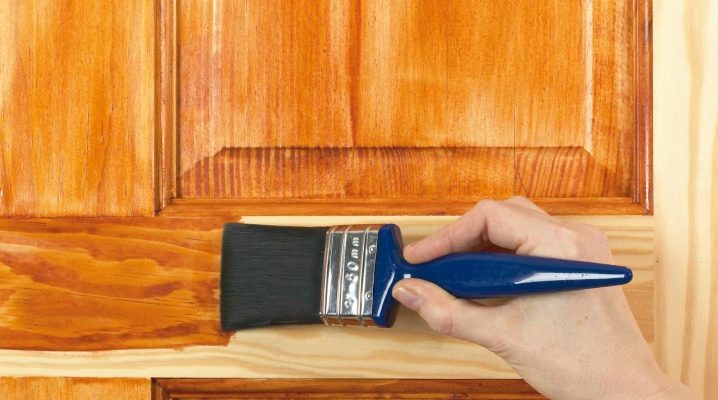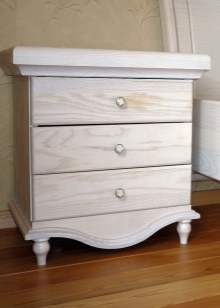Wood stain: types and colors

Stain is an amazing material that will help you quickly and easily transform your interior with minimal investment. It will saturate the wood color and accentuate its pattern.
Peculiarities
The peculiarity of wood stain is its versatility. Forming a special film, it protects the wood from the negative effects of microorganisms, dampness, and mold. This increases the operational life of the products.
After processing, the surface acquires a different color (depending on the shade of the stain itself). You can emphasize the texture of the tree or change its color radically, bringing to life the most interesting design solutions.

Views
Depending on the material that is the basis of the composition, several types of stain are distinguished.
One of the most common types is aquatic. Such a product on the shelves of hardware stores is presented in two versions:
- dry;
- liquid.
The first is a powder for reconstitution with water. Strain it before use. Otherwise, particles of undissolved pigment will interfere with the application of the product in an even layer. The second option is a ready-to-use liquid poured into various containers.
Water stain is economical, does not require special skills in the process of application, inexpensive. Its advantage is non-toxicity and lack of unpleasant odor. It is ideal for interior work. The treated surface will dry for a little over 12 hours.
It is important to take into account that water stain will not drastically change the color of the wood. It will only make it saturated. This will require application in several layers.



Be sure to take into account the peculiarity of such a finishing material. Penetrating deeply, it lifts the grain of the wood. Due to this, the product acquires a spectacular natural look. However, this impact is negative and shortens the life of the wood flooring. The problem can be dealt with if, before applying the composition, treat the tree with water and, after a day, clean it with an emery cloth.
Alcohol stain also sold dry or liquid. To dilute the powder, ethyl alcohol is used. The peculiarity of this composition is fast drying. Therefore, it is often used for outdoor woodworking. If it is required to process the product indoors, good ventilation is necessary, since the stain has a specific pungent odor.
Due to the high drying speed, it is impossible to achieve an even painted surface with a brush. Therefore, the application is carried out with a spray gun.


Oil stain base usually made up of flaxseed oil. White spirit is used for breeding. This composition allows you to paint wooden surfaces in a variety of shades. The stain is easy to apply, penetrating deep into the wood and protecting it from moisture. In this case, you can use a brush, since it does not leave streaks. The only drawback is that it dries for a long time.
Wax stains environmentally friendly and safe for human health. This leads to their high cost. They can be used not only for painting wooden surfaces. They can refurbish or correct imperfections in the wood flooring.


The thickest type of wood stains are gels. They are applied to softwood surfaces. With a brush, such a composition is difficult to distribute, so special tampons are used.Basically, gels are used for outdoor work. They will "revive" the benches and gazebos in the garden, add originality to the facade and fence.
Acrylic stains are based on resins. The tool is an emulsion. It is easy to apply. Penetrating deep enough, the composition protects the surface from the negative effects of moisture. A diverse range of shades will make it possible to translate into reality all the most intimate ideas. At the same time, the processed product will not fade under the sun's rays and will retain its color saturation for a long time. Acrylic stains are economical but expensive.


A special kind of stain is stain. It is based on organic solvents, dyes and pigments. The stain dries quickly and gives an even shade that is resistant to fading.
Hydrogen peroxide or acid is the basis for bleaching stains. Such a composition is intended to make the wooden surface lighter for further processing or painting.

Color spectrum
The modern manufacturer offers an abundance of colors and shades that will make the interior unique and special.
Wenge will allow you to easily give the treated surface the color of this amazing tropical wood: dark brown with black blotches and streaks. The shade looks great in a classic interior, emphasizing the luxury and chic of the environment.
Mahogany also looks expensive. It has brown and red shades. The peculiarity of the composition is that it perfectly emphasizes the structure of the wood. Finished furniture looks good in almost any style.



Black stain is ideal for doorways and doors, floors, stairs and railings. Moreover, if you opt for an oil-based one, then the effect will delight the owner for a long time, since the material is resistant to abrasion.
White is at its peak of popularity right now. It visually expands the space, fills it with comfort. To achieve the bleached oak effect, two types of stain are used. The first coat is a white water-based stain. When it dries, it is treated with an oil composition that contains hard wax. This mixture will clog the pores of the wood and give them a gray or black color.



Colored stain will allow you to give decor and interior items a unique look. The palette of shades has virtually no boundaries.
The dark stain is ideal for creating an ebony effect. To make the imitation high quality, hardwood is used. The surface must be polished before staining.
Blue and blue stains are not used very often in practice. Its main advantage is the ability to give some expressiveness to the finished product.
The blue stain goes well with the yellow and white colors of the interior.


The red stain will accentuate the treated element. However, designers advise against using this color in the bedroom.
The composition of gray is used only in synthesis with a bright color scheme. Otherwise, the interior will radiate despondency and depression.
Green has a calming effect. It looks good with yellow. Combine light and dark stains for amazing effects. Colorless compounds are designed not only to protect wood from negative environmental factors, but also to extend its service life.

What effects can you create?
One of the most common effects widely used in interior design is the aging effect. In this case, a dark stain is used.
At the initial stage, the surface should be treated with a water-based stain so that there are no gaps and unpainted areas. Until the layer is dry, it is processed with a soft sponge. It removes some of the applied mixture. The product is left to dry.
Further, the surface is treated with a composition based on organic compounds.The shade is fixed with a shellac primer. The final stage is varnishing.

It so happens that when combining different types of stains, an amazing effect is achieved.
However, it is necessary to strictly follow the rules: first, the main background is applied, and then the texture of the wood is emphasized with a different color.
To imitate a noble wood such as pine or oak, the grinding method is used. The process is characterized by meticulousness and accuracy. Therefore, quick-drying compositions are not recommended for this type of work.


Usage Tips
In order not to make a mistake in choosing and acquire the composition of the required color, take a tablet with you. Indeed, depending on the nature of the wood, the stain will also manifest itself in different ways. Deciduous trees absorb stain well, conifers do not.
The wood surface must be prepared prior to application. Residues of paint are removed from it with sandpaper. With the help of white spirit, degreasing is performed.


Resin tree species are treated with a special compoundthat prevents the release of resin. You can cook it yourself. Potassium carbonate (50 g), soda ash (60 g) are diluted in hot water (1 liter). The surface is processed, washed with clean water, dried.
To enhance the beauty of the wood grain, the stain should be applied along the grain. Be sure to consider the consistency of the composition. Too thick will make it difficult to apply, and liquid will not give the desired shade saturation.



The stain is applied using a different inventory. The brush is the most common one. It is easy to use and will allow you to beat the pattern and color saturation at your own discretion. At the same time, purchase high-quality brushes that will not lose villi in the process.
It is convenient to handle small areas with a roller. The spray gun sprays the composition evenly without smudges. It is convenient for large areas, especially if the stain dries quickly. Surrounding surfaces will need to be protected with polyethylene.
Use multiple coats to enhance the color of the surface. Each subsequent one is applied after the previous one has completely dried. In this case, the first layer should be the thinnest.



When staining, it is important not to go into places that have already been stained. Otherwise, the color will be uneven.
Water (water stains) or white spirit (oil stains) are used as a diluent.
See below for what to consider when choosing a stain.











The comment was sent successfully.